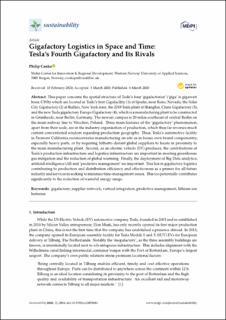| dc.description.abstract | This paper concerns the spatial structure of Tesla’s four ‘gigafactories’ (‘giga’ is gigawatt hour, GWh) which are located in Tesla’s first Gigafacility (1) at Sparks, near Reno, Nevada; the Solar City Gigafactory (2) at Buffalo, New York state; the 2019 Tesla plant at Shanghai, China Gigafactory (3); and the new Tesla gigafactory Europe Gigafactory (4), which is a manufacturing plant to be constructed in Grünheide, near Berlin, Germany. The newest campus is 20 miles southeast of central Berlin on the main railway line to Wrocław, Poland. Three main features of the ‘gigafactory’ phenomenon, apart from their scale, are in the industry organisation of production, which thus far reverses much current conventional wisdom regarding production geography. Thus, Tesla’s automotive facility in Fremont California reconcentrates manufacturing on site as in-house own brand componentry, especially heavy parts, or by requiring hitherto distant global suppliers to locate in proximity to the main manufacturing plant. Second, as an electric vehicle (EV) producer, the contributions of Tesla’s production infrastructure and logistics infrastructure are important in meeting greenhouse gas mitigation and the reduction of global warming. Finally, the deployment of Big Data analytics, artificial intelligence (AI) and ‘predictive management’ are important. This lies in gigafactory logistics contributing to production and distribution efficiency and effectiveness as a primer for all future industry and services in seeking to minimise time-management issues. This too potentially contributes significantly to the reduction of wasteful energy usage. | en_US |

